Ship Chartering and Shipping Lines: Clauses and Environmental Impact
VerifiedAdded on 2023/06/15
|12
|2616
|312
AI Summary
This article discusses the clauses in ship chartering and shipping lines, including naming of ports, laytime, bills of lading, and demurrage. It also explores the impact of environmental policies on the industry and the use of information technology. The article cites real-life examples and studies to support its arguments.
Contribute Materials
Your contribution can guide someone’s learning journey. Share your
documents today.
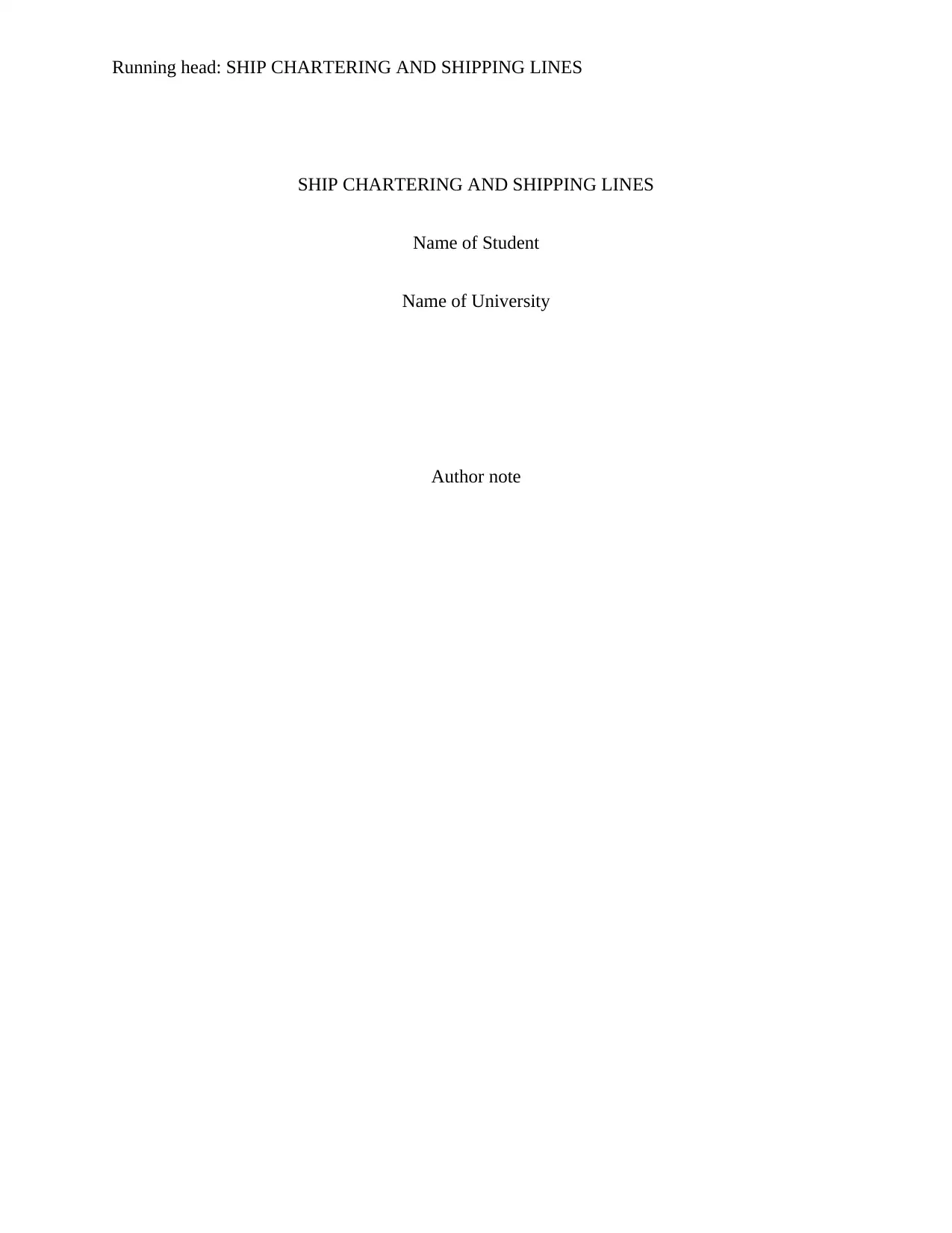
Running head: SHIP CHARTERING AND SHIPPING LINES
SHIP CHARTERING AND SHIPPING LINES
Name of Student
Name of University
Author note
SHIP CHARTERING AND SHIPPING LINES
Name of Student
Name of University
Author note
Secure Best Marks with AI Grader
Need help grading? Try our AI Grader for instant feedback on your assignments.
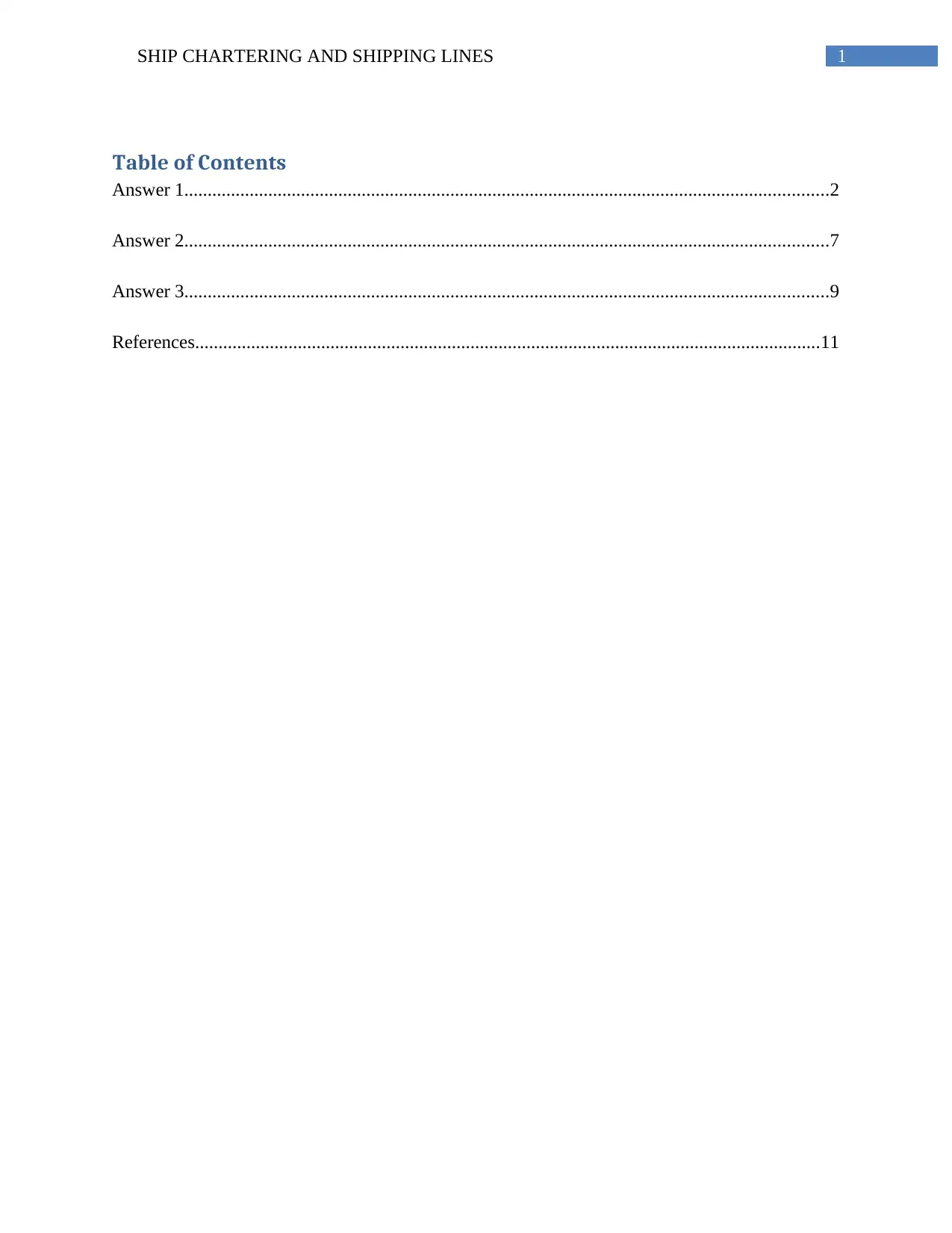
1SHIP CHARTERING AND SHIPPING LINES
Table of Contents
Answer 1..........................................................................................................................................2
Answer 2..........................................................................................................................................7
Answer 3..........................................................................................................................................9
References......................................................................................................................................11
Table of Contents
Answer 1..........................................................................................................................................2
Answer 2..........................................................................................................................................7
Answer 3..........................................................................................................................................9
References......................................................................................................................................11
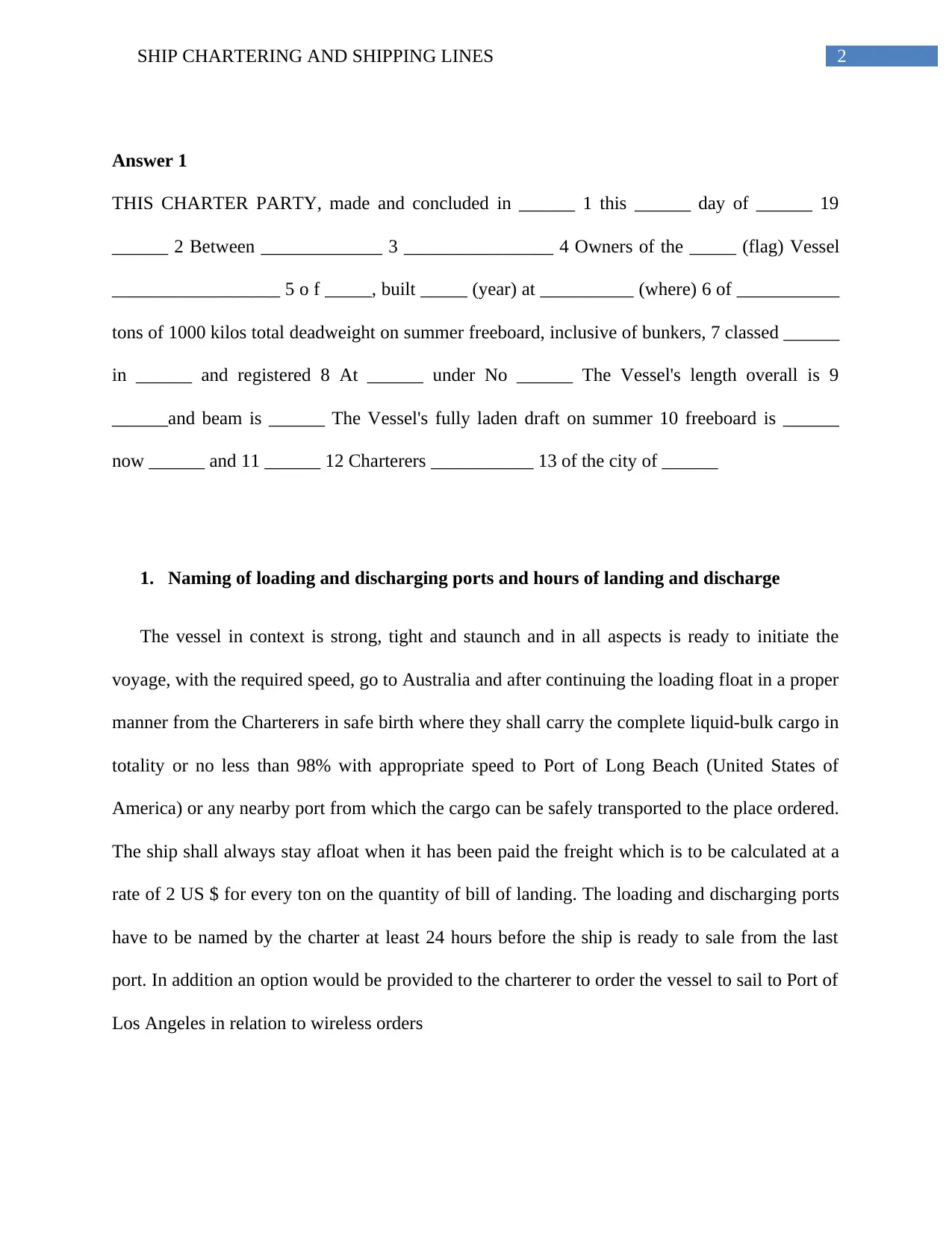
2SHIP CHARTERING AND SHIPPING LINES
Answer 1
THIS CHARTER PARTY, made and concluded in ______ 1 this ______ day of ______ 19
______ 2 Between _____________ 3 ________________ 4 Owners of the _____ (flag) Vessel
__________________ 5 o f _____, built _____ (year) at __________ (where) 6 of ___________
tons of 1000 kilos total deadweight on summer freeboard, inclusive of bunkers, 7 classed ______
in ______ and registered 8 At ______ under No ______ The Vessel's length overall is 9
______and beam is ______ The Vessel's fully laden draft on summer 10 freeboard is ______
now ______ and 11 ______ 12 Charterers ___________ 13 of the city of ______
1. Naming of loading and discharging ports and hours of landing and discharge
The vessel in context is strong, tight and staunch and in all aspects is ready to initiate the
voyage, with the required speed, go to Australia and after continuing the loading float in a proper
manner from the Charterers in safe birth where they shall carry the complete liquid-bulk cargo in
totality or no less than 98% with appropriate speed to Port of Long Beach (United States of
America) or any nearby port from which the cargo can be safely transported to the place ordered.
The ship shall always stay afloat when it has been paid the freight which is to be calculated at a
rate of 2 US $ for every ton on the quantity of bill of landing. The loading and discharging ports
have to be named by the charter at least 24 hours before the ship is ready to sale from the last
port. In addition an option would be provided to the charterer to order the vessel to sail to Port of
Los Angeles in relation to wireless orders
Answer 1
THIS CHARTER PARTY, made and concluded in ______ 1 this ______ day of ______ 19
______ 2 Between _____________ 3 ________________ 4 Owners of the _____ (flag) Vessel
__________________ 5 o f _____, built _____ (year) at __________ (where) 6 of ___________
tons of 1000 kilos total deadweight on summer freeboard, inclusive of bunkers, 7 classed ______
in ______ and registered 8 At ______ under No ______ The Vessel's length overall is 9
______and beam is ______ The Vessel's fully laden draft on summer 10 freeboard is ______
now ______ and 11 ______ 12 Charterers ___________ 13 of the city of ______
1. Naming of loading and discharging ports and hours of landing and discharge
The vessel in context is strong, tight and staunch and in all aspects is ready to initiate the
voyage, with the required speed, go to Australia and after continuing the loading float in a proper
manner from the Charterers in safe birth where they shall carry the complete liquid-bulk cargo in
totality or no less than 98% with appropriate speed to Port of Long Beach (United States of
America) or any nearby port from which the cargo can be safely transported to the place ordered.
The ship shall always stay afloat when it has been paid the freight which is to be calculated at a
rate of 2 US $ for every ton on the quantity of bill of landing. The loading and discharging ports
have to be named by the charter at least 24 hours before the ship is ready to sale from the last
port. In addition an option would be provided to the charterer to order the vessel to sail to Port of
Los Angeles in relation to wireless orders
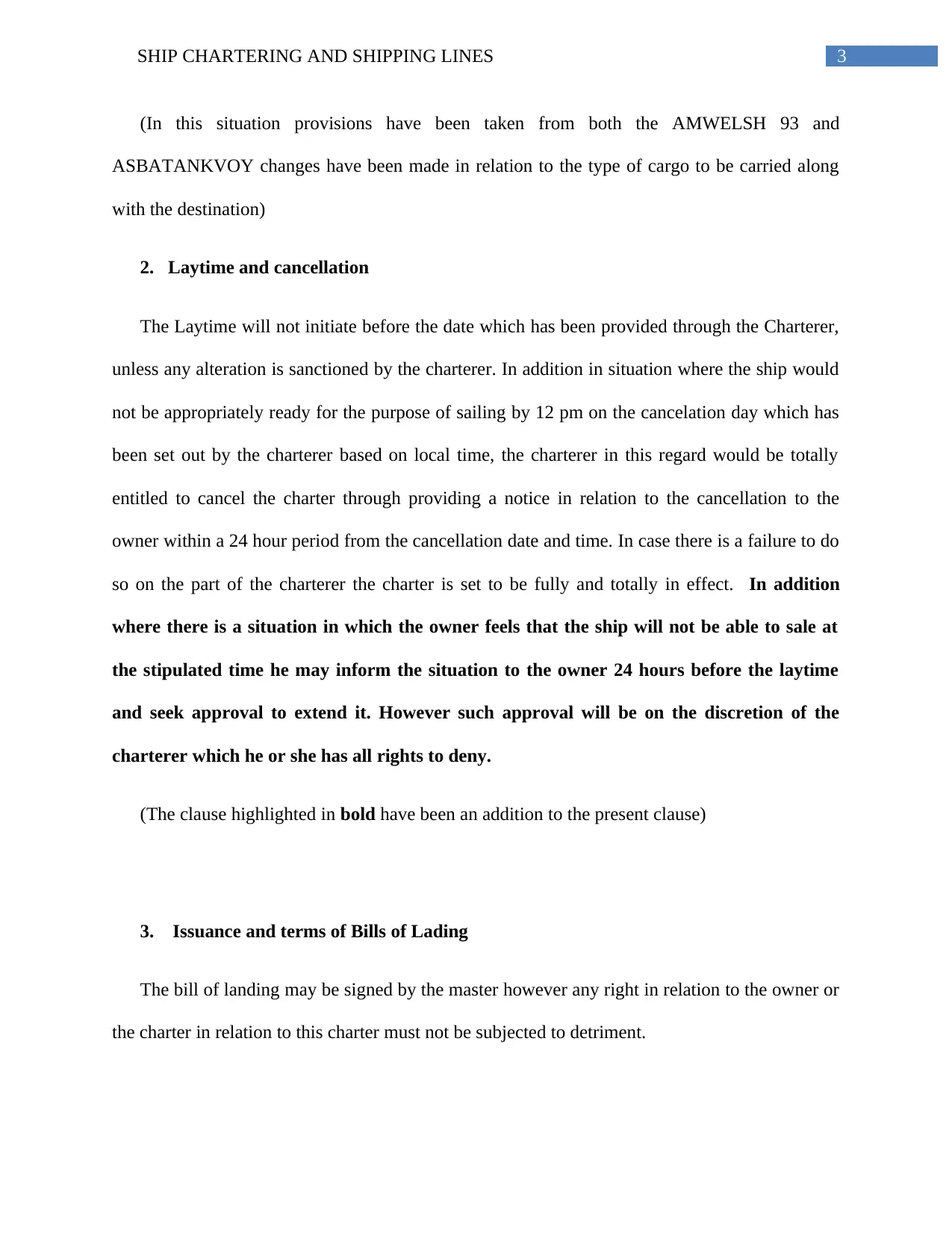
3SHIP CHARTERING AND SHIPPING LINES
(In this situation provisions have been taken from both the AMWELSH 93 and
ASBATANKVOY changes have been made in relation to the type of cargo to be carried along
with the destination)
2. Laytime and cancellation
The Laytime will not initiate before the date which has been provided through the Charterer,
unless any alteration is sanctioned by the charterer. In addition in situation where the ship would
not be appropriately ready for the purpose of sailing by 12 pm on the cancelation day which has
been set out by the charterer based on local time, the charterer in this regard would be totally
entitled to cancel the charter through providing a notice in relation to the cancellation to the
owner within a 24 hour period from the cancellation date and time. In case there is a failure to do
so on the part of the charterer the charter is set to be fully and totally in effect. In addition
where there is a situation in which the owner feels that the ship will not be able to sale at
the stipulated time he may inform the situation to the owner 24 hours before the laytime
and seek approval to extend it. However such approval will be on the discretion of the
charterer which he or she has all rights to deny.
(The clause highlighted in bold have been an addition to the present clause)
3. Issuance and terms of Bills of Lading
The bill of landing may be signed by the master however any right in relation to the owner or
the charter in relation to this charter must not be subjected to detriment.
(In this situation provisions have been taken from both the AMWELSH 93 and
ASBATANKVOY changes have been made in relation to the type of cargo to be carried along
with the destination)
2. Laytime and cancellation
The Laytime will not initiate before the date which has been provided through the Charterer,
unless any alteration is sanctioned by the charterer. In addition in situation where the ship would
not be appropriately ready for the purpose of sailing by 12 pm on the cancelation day which has
been set out by the charterer based on local time, the charterer in this regard would be totally
entitled to cancel the charter through providing a notice in relation to the cancellation to the
owner within a 24 hour period from the cancellation date and time. In case there is a failure to do
so on the part of the charterer the charter is set to be fully and totally in effect. In addition
where there is a situation in which the owner feels that the ship will not be able to sale at
the stipulated time he may inform the situation to the owner 24 hours before the laytime
and seek approval to extend it. However such approval will be on the discretion of the
charterer which he or she has all rights to deny.
(The clause highlighted in bold have been an addition to the present clause)
3. Issuance and terms of Bills of Lading
The bill of landing may be signed by the master however any right in relation to the owner or
the charter in relation to this charter must not be subjected to detriment.
Paraphrase This Document
Need a fresh take? Get an instant paraphrase of this document with our AI Paraphraser
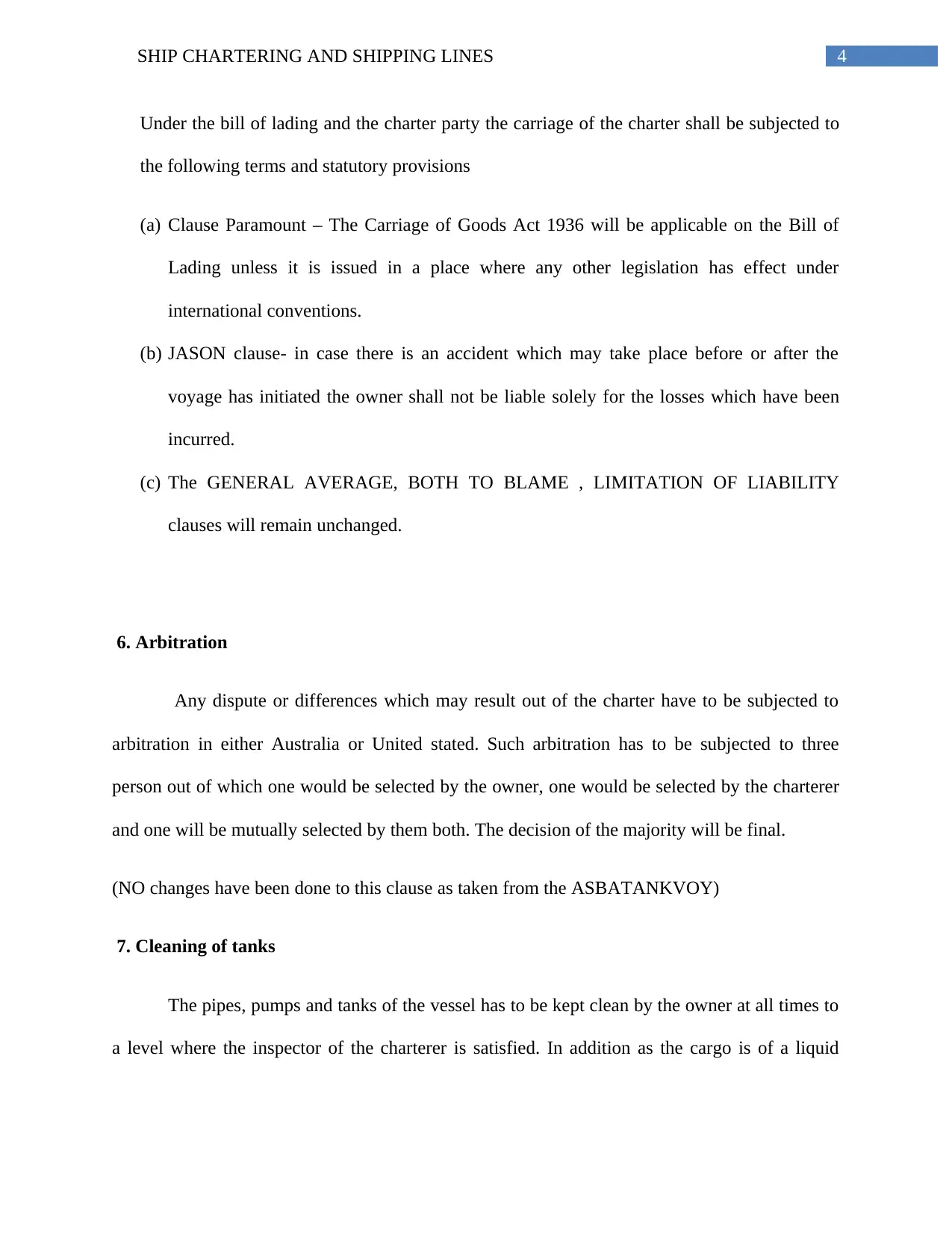
4SHIP CHARTERING AND SHIPPING LINES
Under the bill of lading and the charter party the carriage of the charter shall be subjected to
the following terms and statutory provisions
(a) Clause Paramount – The Carriage of Goods Act 1936 will be applicable on the Bill of
Lading unless it is issued in a place where any other legislation has effect under
international conventions.
(b) JASON clause- in case there is an accident which may take place before or after the
voyage has initiated the owner shall not be liable solely for the losses which have been
incurred.
(c) The GENERAL AVERAGE, BOTH TO BLAME , LIMITATION OF LIABILITY
clauses will remain unchanged.
6. Arbitration
Any dispute or differences which may result out of the charter have to be subjected to
arbitration in either Australia or United stated. Such arbitration has to be subjected to three
person out of which one would be selected by the owner, one would be selected by the charterer
and one will be mutually selected by them both. The decision of the majority will be final.
(NO changes have been done to this clause as taken from the ASBATANKVOY)
7. Cleaning of tanks
The pipes, pumps and tanks of the vessel has to be kept clean by the owner at all times to
a level where the inspector of the charterer is satisfied. In addition as the cargo is of a liquid
Under the bill of lading and the charter party the carriage of the charter shall be subjected to
the following terms and statutory provisions
(a) Clause Paramount – The Carriage of Goods Act 1936 will be applicable on the Bill of
Lading unless it is issued in a place where any other legislation has effect under
international conventions.
(b) JASON clause- in case there is an accident which may take place before or after the
voyage has initiated the owner shall not be liable solely for the losses which have been
incurred.
(c) The GENERAL AVERAGE, BOTH TO BLAME , LIMITATION OF LIABILITY
clauses will remain unchanged.
6. Arbitration
Any dispute or differences which may result out of the charter have to be subjected to
arbitration in either Australia or United stated. Such arbitration has to be subjected to three
person out of which one would be selected by the owner, one would be selected by the charterer
and one will be mutually selected by them both. The decision of the majority will be final.
(NO changes have been done to this clause as taken from the ASBATANKVOY)
7. Cleaning of tanks
The pipes, pumps and tanks of the vessel has to be kept clean by the owner at all times to
a level where the inspector of the charterer is satisfied. In addition as the cargo is of a liquid
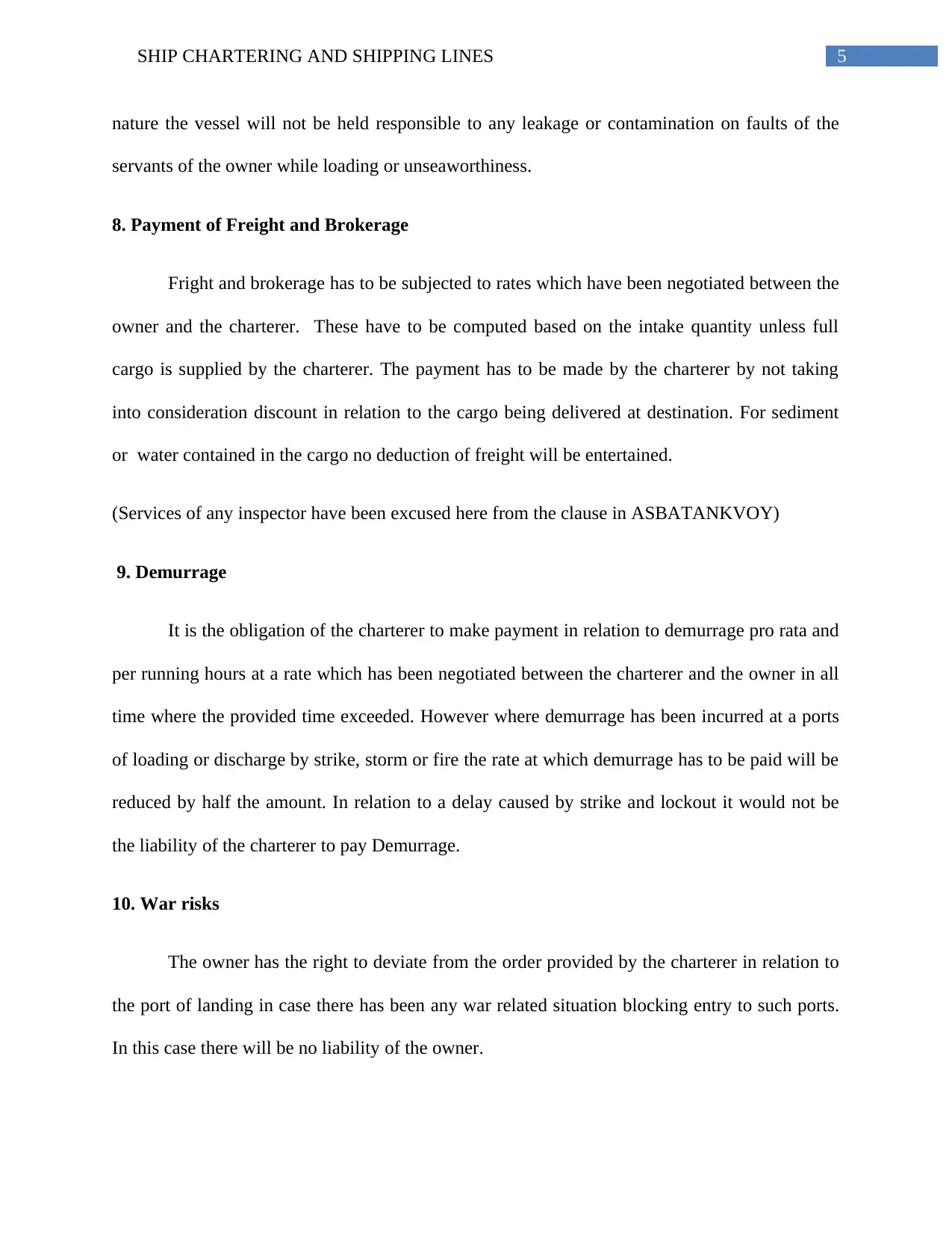
5SHIP CHARTERING AND SHIPPING LINES
nature the vessel will not be held responsible to any leakage or contamination on faults of the
servants of the owner while loading or unseaworthiness.
8. Payment of Freight and Brokerage
Fright and brokerage has to be subjected to rates which have been negotiated between the
owner and the charterer. These have to be computed based on the intake quantity unless full
cargo is supplied by the charterer. The payment has to be made by the charterer by not taking
into consideration discount in relation to the cargo being delivered at destination. For sediment
or water contained in the cargo no deduction of freight will be entertained.
(Services of any inspector have been excused here from the clause in ASBATANKVOY)
9. Demurrage
It is the obligation of the charterer to make payment in relation to demurrage pro rata and
per running hours at a rate which has been negotiated between the charterer and the owner in all
time where the provided time exceeded. However where demurrage has been incurred at a ports
of loading or discharge by strike, storm or fire the rate at which demurrage has to be paid will be
reduced by half the amount. In relation to a delay caused by strike and lockout it would not be
the liability of the charterer to pay Demurrage.
10. War risks
The owner has the right to deviate from the order provided by the charterer in relation to
the port of landing in case there has been any war related situation blocking entry to such ports.
In this case there will be no liability of the owner.
nature the vessel will not be held responsible to any leakage or contamination on faults of the
servants of the owner while loading or unseaworthiness.
8. Payment of Freight and Brokerage
Fright and brokerage has to be subjected to rates which have been negotiated between the
owner and the charterer. These have to be computed based on the intake quantity unless full
cargo is supplied by the charterer. The payment has to be made by the charterer by not taking
into consideration discount in relation to the cargo being delivered at destination. For sediment
or water contained in the cargo no deduction of freight will be entertained.
(Services of any inspector have been excused here from the clause in ASBATANKVOY)
9. Demurrage
It is the obligation of the charterer to make payment in relation to demurrage pro rata and
per running hours at a rate which has been negotiated between the charterer and the owner in all
time where the provided time exceeded. However where demurrage has been incurred at a ports
of loading or discharge by strike, storm or fire the rate at which demurrage has to be paid will be
reduced by half the amount. In relation to a delay caused by strike and lockout it would not be
the liability of the charterer to pay Demurrage.
10. War risks
The owner has the right to deviate from the order provided by the charterer in relation to
the port of landing in case there has been any war related situation blocking entry to such ports.
In this case there will be no liability of the owner.
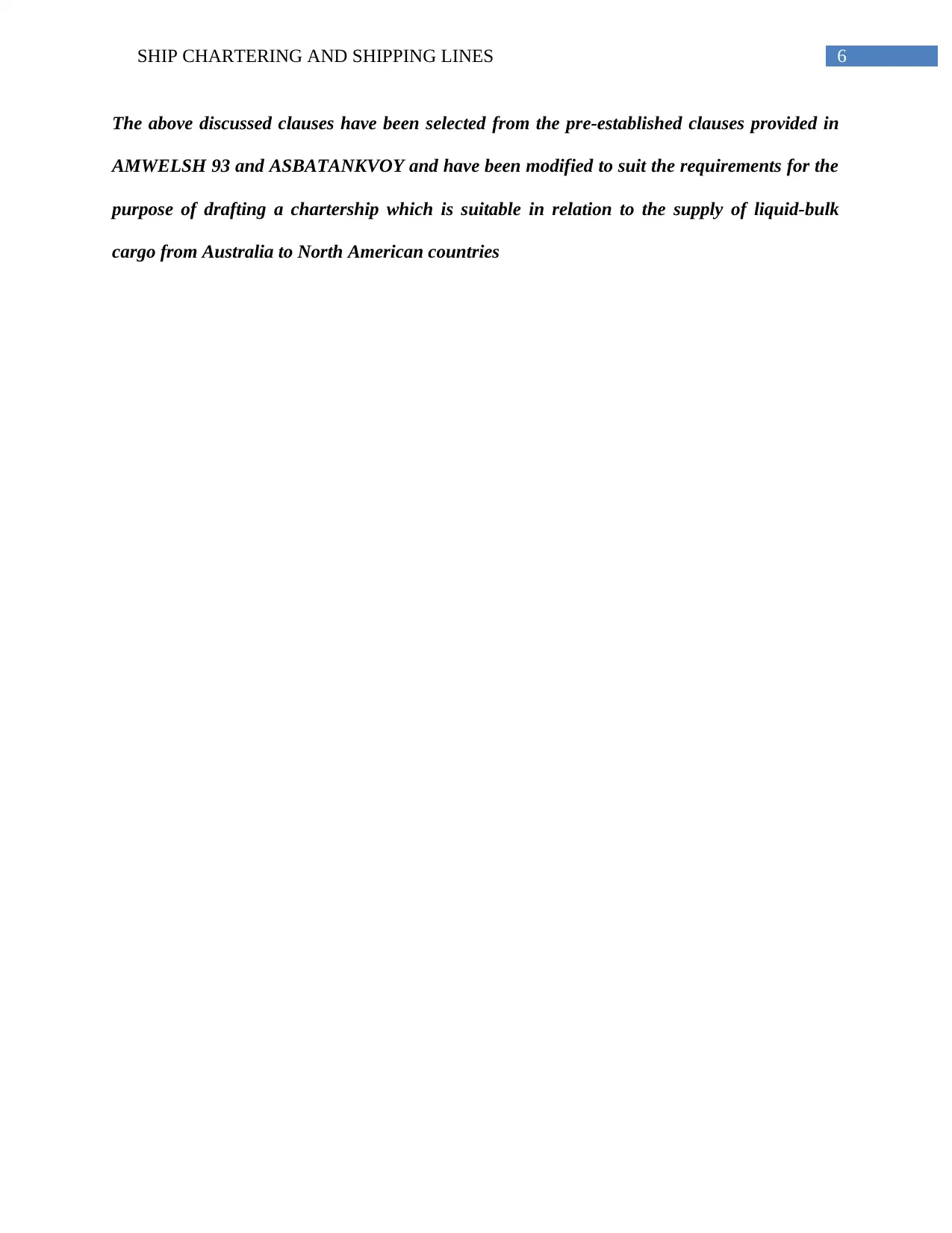
6SHIP CHARTERING AND SHIPPING LINES
The above discussed clauses have been selected from the pre-established clauses provided in
AMWELSH 93 and ASBATANKVOY and have been modified to suit the requirements for the
purpose of drafting a chartership which is suitable in relation to the supply of liquid-bulk
cargo from Australia to North American countries
The above discussed clauses have been selected from the pre-established clauses provided in
AMWELSH 93 and ASBATANKVOY and have been modified to suit the requirements for the
purpose of drafting a chartership which is suitable in relation to the supply of liquid-bulk
cargo from Australia to North American countries
Secure Best Marks with AI Grader
Need help grading? Try our AI Grader for instant feedback on your assignments.
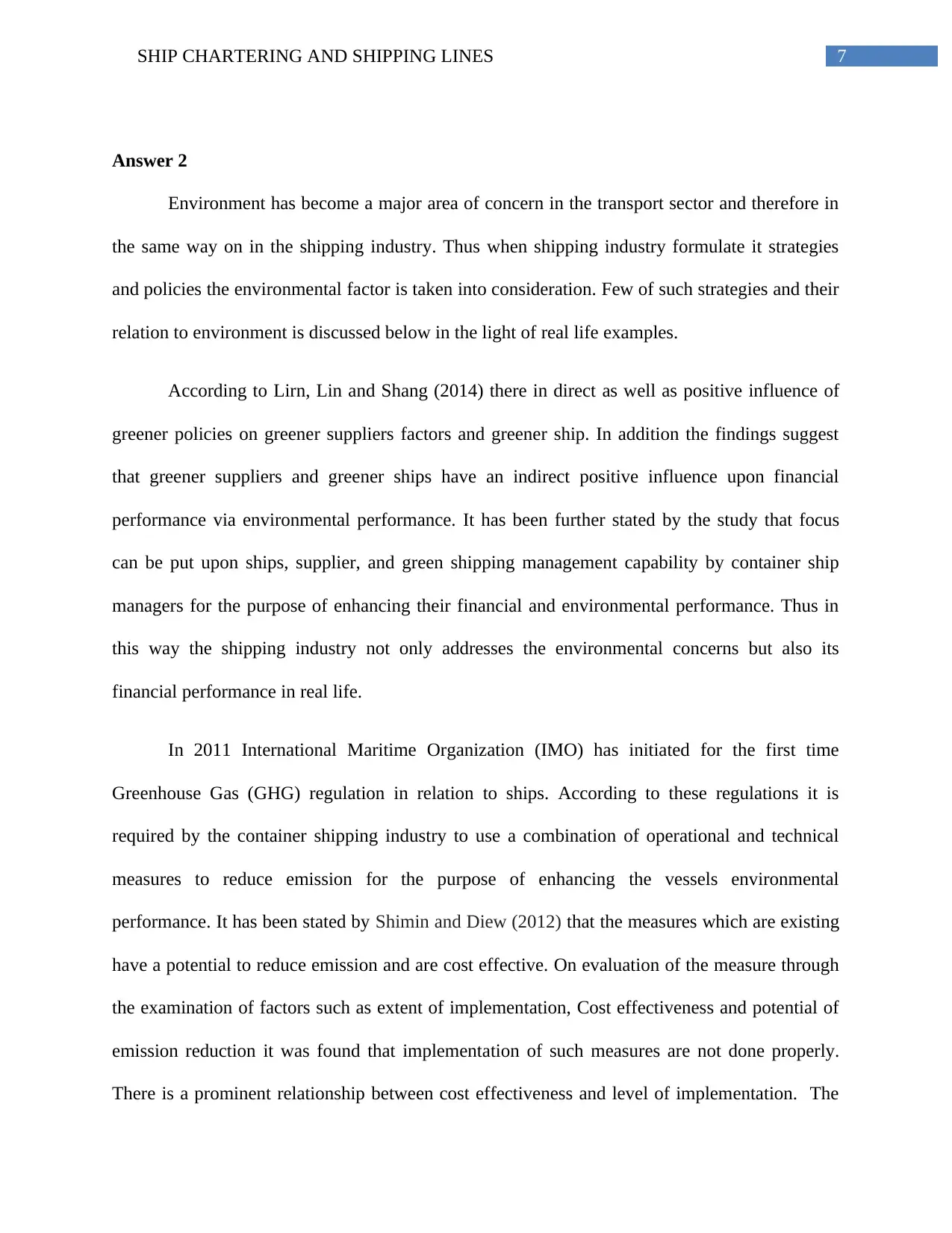
7SHIP CHARTERING AND SHIPPING LINES
Answer 2
Environment has become a major area of concern in the transport sector and therefore in
the same way on in the shipping industry. Thus when shipping industry formulate it strategies
and policies the environmental factor is taken into consideration. Few of such strategies and their
relation to environment is discussed below in the light of real life examples.
According to Lirn, Lin and Shang (2014) there in direct as well as positive influence of
greener policies on greener suppliers factors and greener ship. In addition the findings suggest
that greener suppliers and greener ships have an indirect positive influence upon financial
performance via environmental performance. It has been further stated by the study that focus
can be put upon ships, supplier, and green shipping management capability by container ship
managers for the purpose of enhancing their financial and environmental performance. Thus in
this way the shipping industry not only addresses the environmental concerns but also its
financial performance in real life.
In 2011 International Maritime Organization (IMO) has initiated for the first time
Greenhouse Gas (GHG) regulation in relation to ships. According to these regulations it is
required by the container shipping industry to use a combination of operational and technical
measures to reduce emission for the purpose of enhancing the vessels environmental
performance. It has been stated by Shimin and Diew (2012) that the measures which are existing
have a potential to reduce emission and are cost effective. On evaluation of the measure through
the examination of factors such as extent of implementation, Cost effectiveness and potential of
emission reduction it was found that implementation of such measures are not done properly.
There is a prominent relationship between cost effectiveness and level of implementation. The
Answer 2
Environment has become a major area of concern in the transport sector and therefore in
the same way on in the shipping industry. Thus when shipping industry formulate it strategies
and policies the environmental factor is taken into consideration. Few of such strategies and their
relation to environment is discussed below in the light of real life examples.
According to Lirn, Lin and Shang (2014) there in direct as well as positive influence of
greener policies on greener suppliers factors and greener ship. In addition the findings suggest
that greener suppliers and greener ships have an indirect positive influence upon financial
performance via environmental performance. It has been further stated by the study that focus
can be put upon ships, supplier, and green shipping management capability by container ship
managers for the purpose of enhancing their financial and environmental performance. Thus in
this way the shipping industry not only addresses the environmental concerns but also its
financial performance in real life.
In 2011 International Maritime Organization (IMO) has initiated for the first time
Greenhouse Gas (GHG) regulation in relation to ships. According to these regulations it is
required by the container shipping industry to use a combination of operational and technical
measures to reduce emission for the purpose of enhancing the vessels environmental
performance. It has been stated by Shimin and Diew (2012) that the measures which are existing
have a potential to reduce emission and are cost effective. On evaluation of the measure through
the examination of factors such as extent of implementation, Cost effectiveness and potential of
emission reduction it was found that implementation of such measures are not done properly.
There is a prominent relationship between cost effectiveness and level of implementation. The
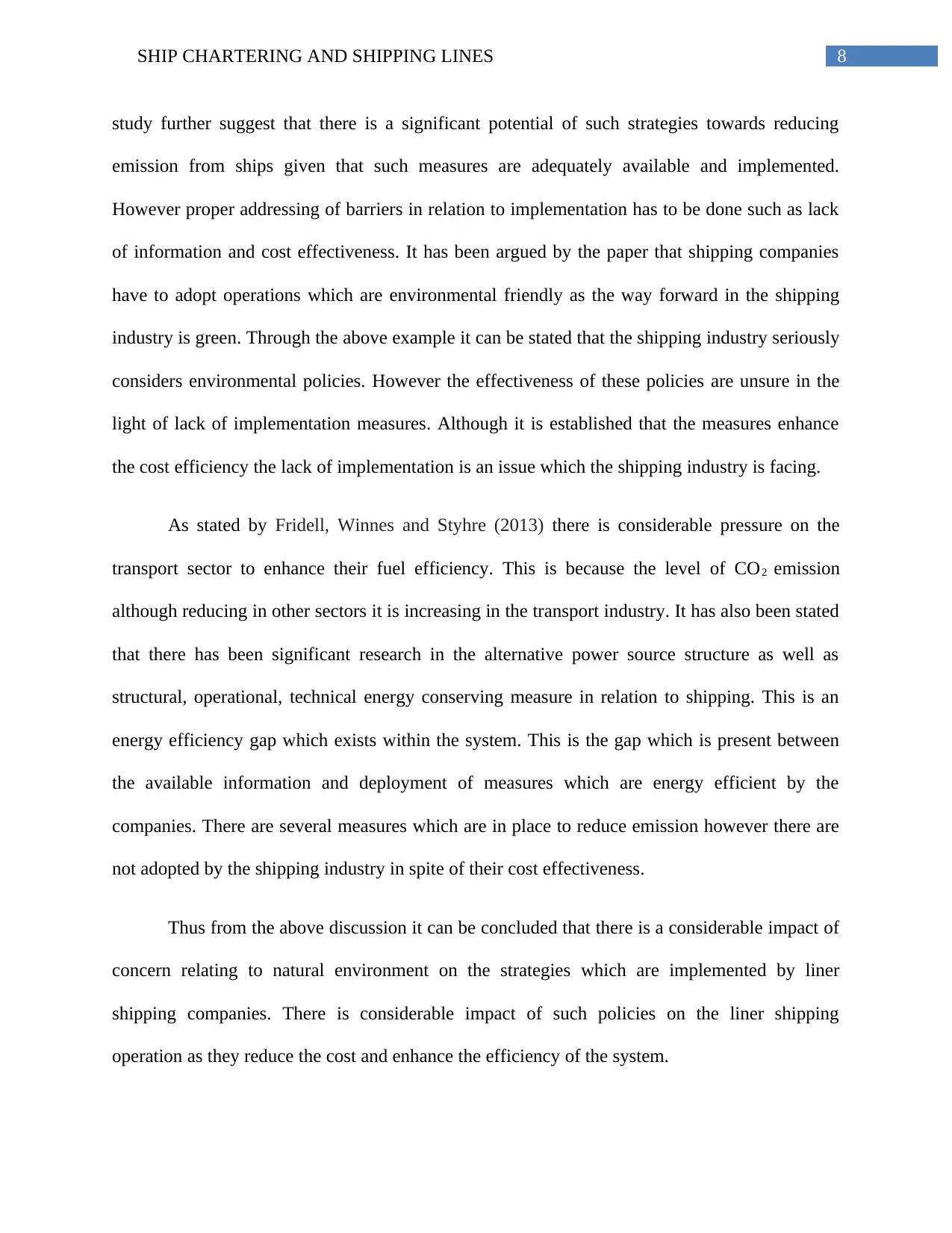
8SHIP CHARTERING AND SHIPPING LINES
study further suggest that there is a significant potential of such strategies towards reducing
emission from ships given that such measures are adequately available and implemented.
However proper addressing of barriers in relation to implementation has to be done such as lack
of information and cost effectiveness. It has been argued by the paper that shipping companies
have to adopt operations which are environmental friendly as the way forward in the shipping
industry is green. Through the above example it can be stated that the shipping industry seriously
considers environmental policies. However the effectiveness of these policies are unsure in the
light of lack of implementation measures. Although it is established that the measures enhance
the cost efficiency the lack of implementation is an issue which the shipping industry is facing.
As stated by Fridell, Winnes and Styhre (2013) there is considerable pressure on the
transport sector to enhance their fuel efficiency. This is because the level of CO2 emission
although reducing in other sectors it is increasing in the transport industry. It has also been stated
that there has been significant research in the alternative power source structure as well as
structural, operational, technical energy conserving measure in relation to shipping. This is an
energy efficiency gap which exists within the system. This is the gap which is present between
the available information and deployment of measures which are energy efficient by the
companies. There are several measures which are in place to reduce emission however there are
not adopted by the shipping industry in spite of their cost effectiveness.
Thus from the above discussion it can be concluded that there is a considerable impact of
concern relating to natural environment on the strategies which are implemented by liner
shipping companies. There is considerable impact of such policies on the liner shipping
operation as they reduce the cost and enhance the efficiency of the system.
study further suggest that there is a significant potential of such strategies towards reducing
emission from ships given that such measures are adequately available and implemented.
However proper addressing of barriers in relation to implementation has to be done such as lack
of information and cost effectiveness. It has been argued by the paper that shipping companies
have to adopt operations which are environmental friendly as the way forward in the shipping
industry is green. Through the above example it can be stated that the shipping industry seriously
considers environmental policies. However the effectiveness of these policies are unsure in the
light of lack of implementation measures. Although it is established that the measures enhance
the cost efficiency the lack of implementation is an issue which the shipping industry is facing.
As stated by Fridell, Winnes and Styhre (2013) there is considerable pressure on the
transport sector to enhance their fuel efficiency. This is because the level of CO2 emission
although reducing in other sectors it is increasing in the transport industry. It has also been stated
that there has been significant research in the alternative power source structure as well as
structural, operational, technical energy conserving measure in relation to shipping. This is an
energy efficiency gap which exists within the system. This is the gap which is present between
the available information and deployment of measures which are energy efficient by the
companies. There are several measures which are in place to reduce emission however there are
not adopted by the shipping industry in spite of their cost effectiveness.
Thus from the above discussion it can be concluded that there is a considerable impact of
concern relating to natural environment on the strategies which are implemented by liner
shipping companies. There is considerable impact of such policies on the liner shipping
operation as they reduce the cost and enhance the efficiency of the system.
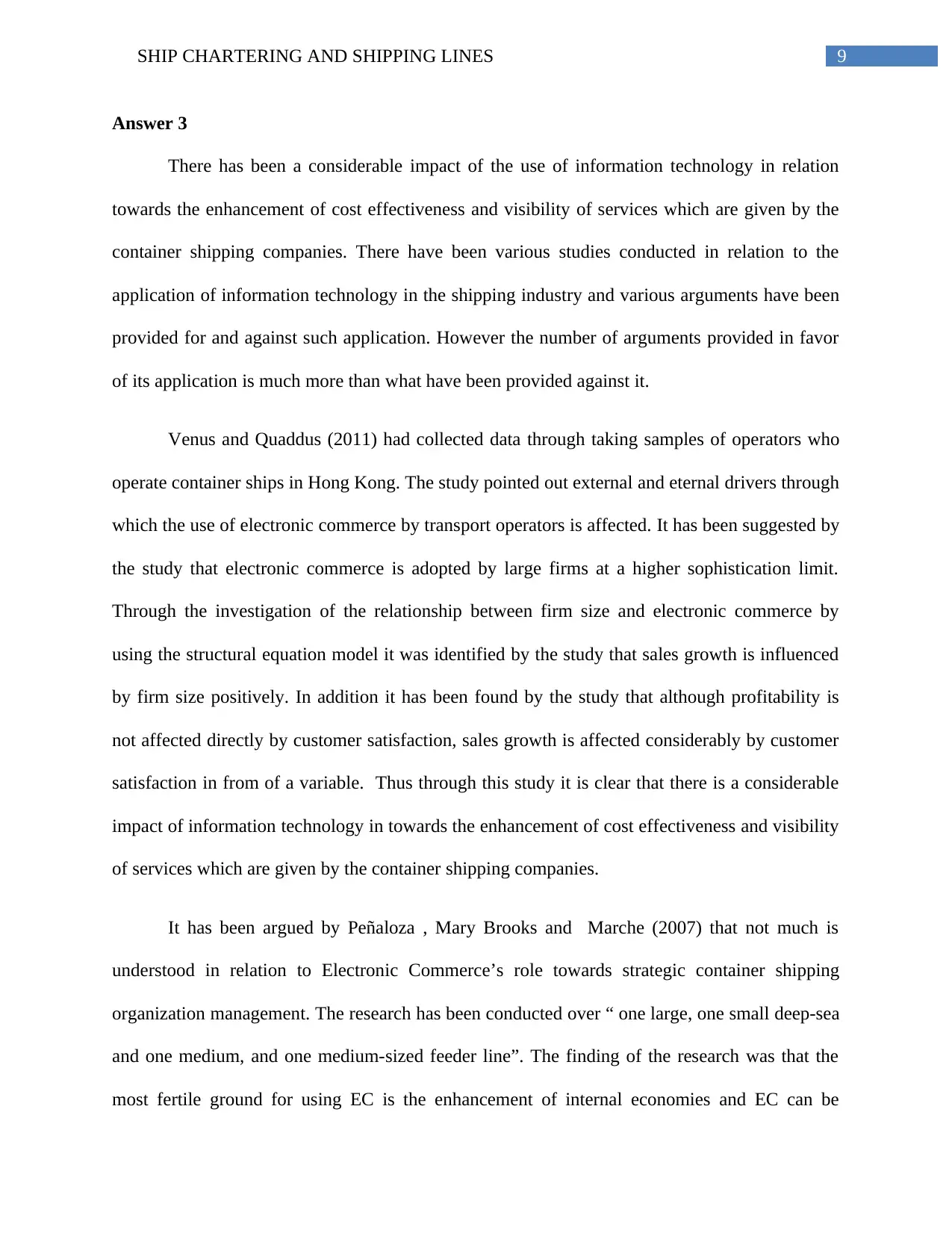
9SHIP CHARTERING AND SHIPPING LINES
Answer 3
There has been a considerable impact of the use of information technology in relation
towards the enhancement of cost effectiveness and visibility of services which are given by the
container shipping companies. There have been various studies conducted in relation to the
application of information technology in the shipping industry and various arguments have been
provided for and against such application. However the number of arguments provided in favor
of its application is much more than what have been provided against it.
Venus and Quaddus (2011) had collected data through taking samples of operators who
operate container ships in Hong Kong. The study pointed out external and eternal drivers through
which the use of electronic commerce by transport operators is affected. It has been suggested by
the study that electronic commerce is adopted by large firms at a higher sophistication limit.
Through the investigation of the relationship between firm size and electronic commerce by
using the structural equation model it was identified by the study that sales growth is influenced
by firm size positively. In addition it has been found by the study that although profitability is
not affected directly by customer satisfaction, sales growth is affected considerably by customer
satisfaction in from of a variable. Thus through this study it is clear that there is a considerable
impact of information technology in towards the enhancement of cost effectiveness and visibility
of services which are given by the container shipping companies.
It has been argued by Peñaloza , Mary Brooks and Marche (2007) that not much is
understood in relation to Electronic Commerce’s role towards strategic container shipping
organization management. The research has been conducted over “ one large, one small deep-sea
and one medium, and one medium-sized feeder line”. The finding of the research was that the
most fertile ground for using EC is the enhancement of internal economies and EC can be
Answer 3
There has been a considerable impact of the use of information technology in relation
towards the enhancement of cost effectiveness and visibility of services which are given by the
container shipping companies. There have been various studies conducted in relation to the
application of information technology in the shipping industry and various arguments have been
provided for and against such application. However the number of arguments provided in favor
of its application is much more than what have been provided against it.
Venus and Quaddus (2011) had collected data through taking samples of operators who
operate container ships in Hong Kong. The study pointed out external and eternal drivers through
which the use of electronic commerce by transport operators is affected. It has been suggested by
the study that electronic commerce is adopted by large firms at a higher sophistication limit.
Through the investigation of the relationship between firm size and electronic commerce by
using the structural equation model it was identified by the study that sales growth is influenced
by firm size positively. In addition it has been found by the study that although profitability is
not affected directly by customer satisfaction, sales growth is affected considerably by customer
satisfaction in from of a variable. Thus through this study it is clear that there is a considerable
impact of information technology in towards the enhancement of cost effectiveness and visibility
of services which are given by the container shipping companies.
It has been argued by Peñaloza , Mary Brooks and Marche (2007) that not much is
understood in relation to Electronic Commerce’s role towards strategic container shipping
organization management. The research has been conducted over “ one large, one small deep-sea
and one medium, and one medium-sized feeder line”. The finding of the research was that the
most fertile ground for using EC is the enhancement of internal economies and EC can be
Paraphrase This Document
Need a fresh take? Get an instant paraphrase of this document with our AI Paraphraser
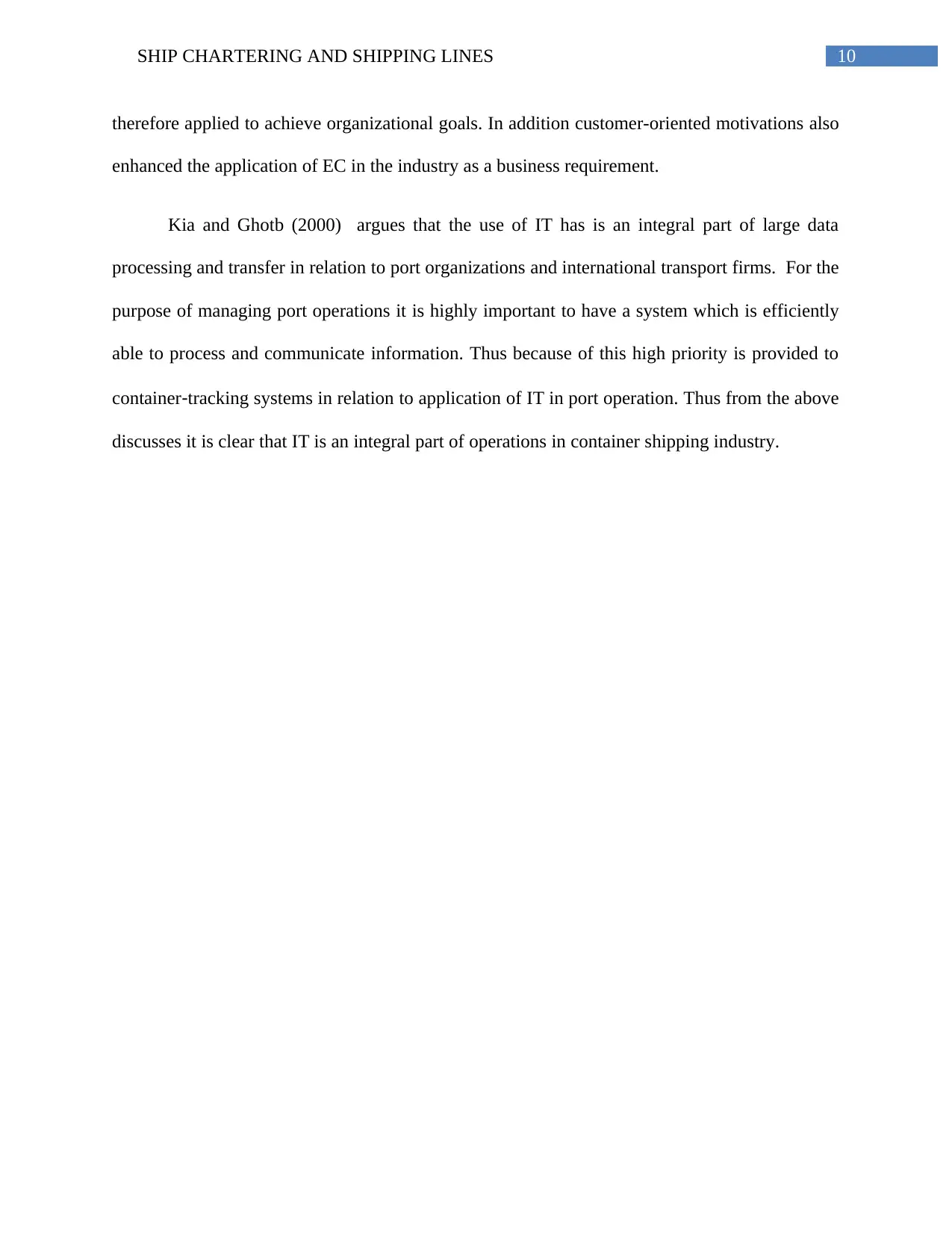
10SHIP CHARTERING AND SHIPPING LINES
therefore applied to achieve organizational goals. In addition customer-oriented motivations also
enhanced the application of EC in the industry as a business requirement.
Kia and Ghotb (2000) argues that the use of IT has is an integral part of large data
processing and transfer in relation to port organizations and international transport firms. For the
purpose of managing port operations it is highly important to have a system which is efficiently
able to process and communicate information. Thus because of this high priority is provided to
container‐tracking systems in relation to application of IT in port operation. Thus from the above
discusses it is clear that IT is an integral part of operations in container shipping industry.
therefore applied to achieve organizational goals. In addition customer-oriented motivations also
enhanced the application of EC in the industry as a business requirement.
Kia and Ghotb (2000) argues that the use of IT has is an integral part of large data
processing and transfer in relation to port organizations and international transport firms. For the
purpose of managing port operations it is highly important to have a system which is efficiently
able to process and communicate information. Thus because of this high priority is provided to
container‐tracking systems in relation to application of IT in port operation. Thus from the above
discusses it is clear that IT is an integral part of operations in container shipping industry.
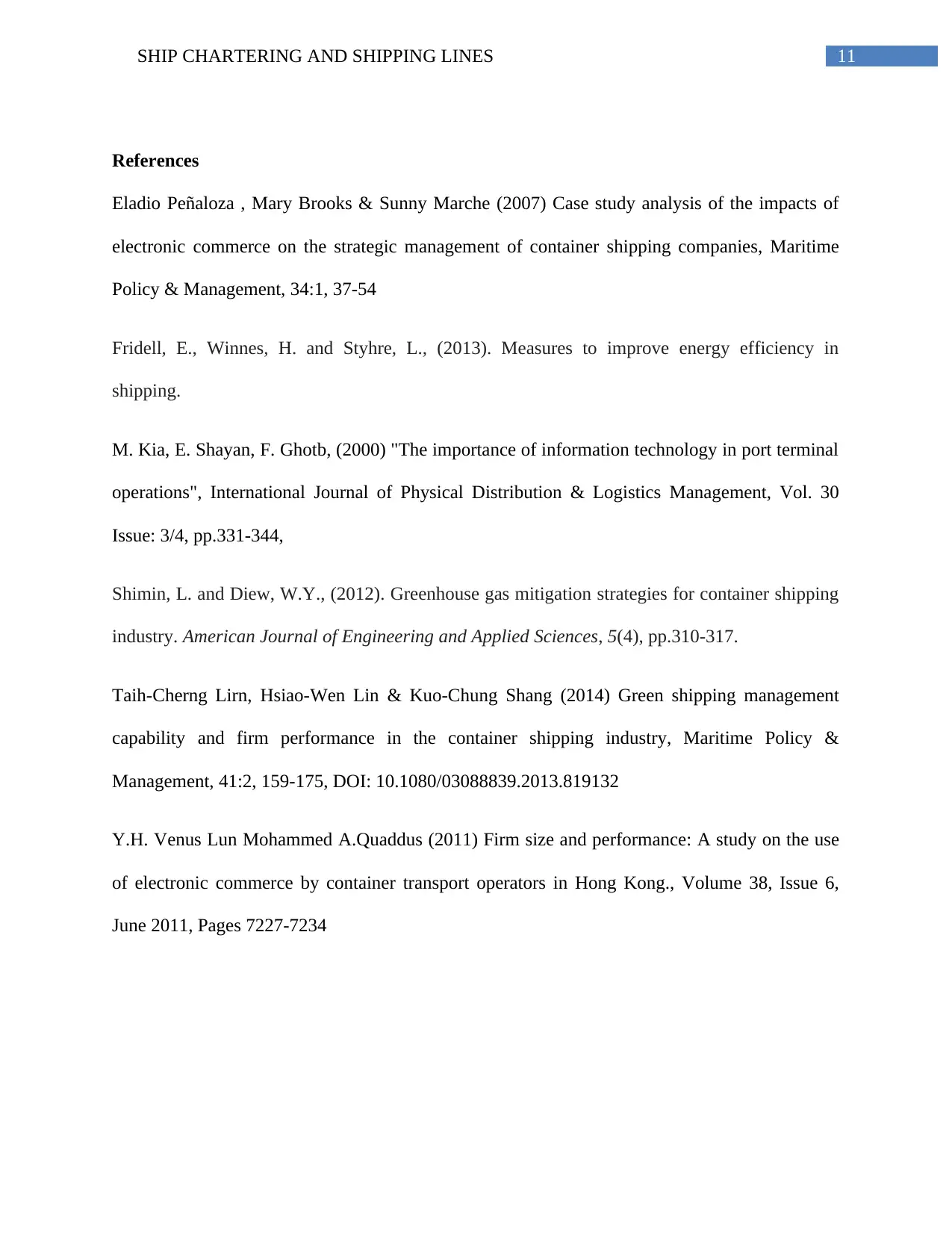
11SHIP CHARTERING AND SHIPPING LINES
References
Eladio Peñaloza , Mary Brooks & Sunny Marche (2007) Case study analysis of the impacts of
electronic commerce on the strategic management of container shipping companies, Maritime
Policy & Management, 34:1, 37-54
Fridell, E., Winnes, H. and Styhre, L., (2013). Measures to improve energy efficiency in
shipping.
M. Kia, E. Shayan, F. Ghotb, (2000) "The importance of information technology in port terminal
operations", International Journal of Physical Distribution & Logistics Management, Vol. 30
Issue: 3/4, pp.331-344,
Shimin, L. and Diew, W.Y., (2012). Greenhouse gas mitigation strategies for container shipping
industry. American Journal of Engineering and Applied Sciences, 5(4), pp.310-317.
Taih-Cherng Lirn, Hsiao-Wen Lin & Kuo-Chung Shang (2014) Green shipping management
capability and firm performance in the container shipping industry, Maritime Policy &
Management, 41:2, 159-175, DOI: 10.1080/03088839.2013.819132
Y.H. Venus Lun Mohammed A.Quaddus (2011) Firm size and performance: A study on the use
of electronic commerce by container transport operators in Hong Kong., Volume 38, Issue 6,
June 2011, Pages 7227-7234
References
Eladio Peñaloza , Mary Brooks & Sunny Marche (2007) Case study analysis of the impacts of
electronic commerce on the strategic management of container shipping companies, Maritime
Policy & Management, 34:1, 37-54
Fridell, E., Winnes, H. and Styhre, L., (2013). Measures to improve energy efficiency in
shipping.
M. Kia, E. Shayan, F. Ghotb, (2000) "The importance of information technology in port terminal
operations", International Journal of Physical Distribution & Logistics Management, Vol. 30
Issue: 3/4, pp.331-344,
Shimin, L. and Diew, W.Y., (2012). Greenhouse gas mitigation strategies for container shipping
industry. American Journal of Engineering and Applied Sciences, 5(4), pp.310-317.
Taih-Cherng Lirn, Hsiao-Wen Lin & Kuo-Chung Shang (2014) Green shipping management
capability and firm performance in the container shipping industry, Maritime Policy &
Management, 41:2, 159-175, DOI: 10.1080/03088839.2013.819132
Y.H. Venus Lun Mohammed A.Quaddus (2011) Firm size and performance: A study on the use
of electronic commerce by container transport operators in Hong Kong., Volume 38, Issue 6,
June 2011, Pages 7227-7234
1 out of 12
![[object Object]](/_next/static/media/star-bottom.7253800d.svg)
